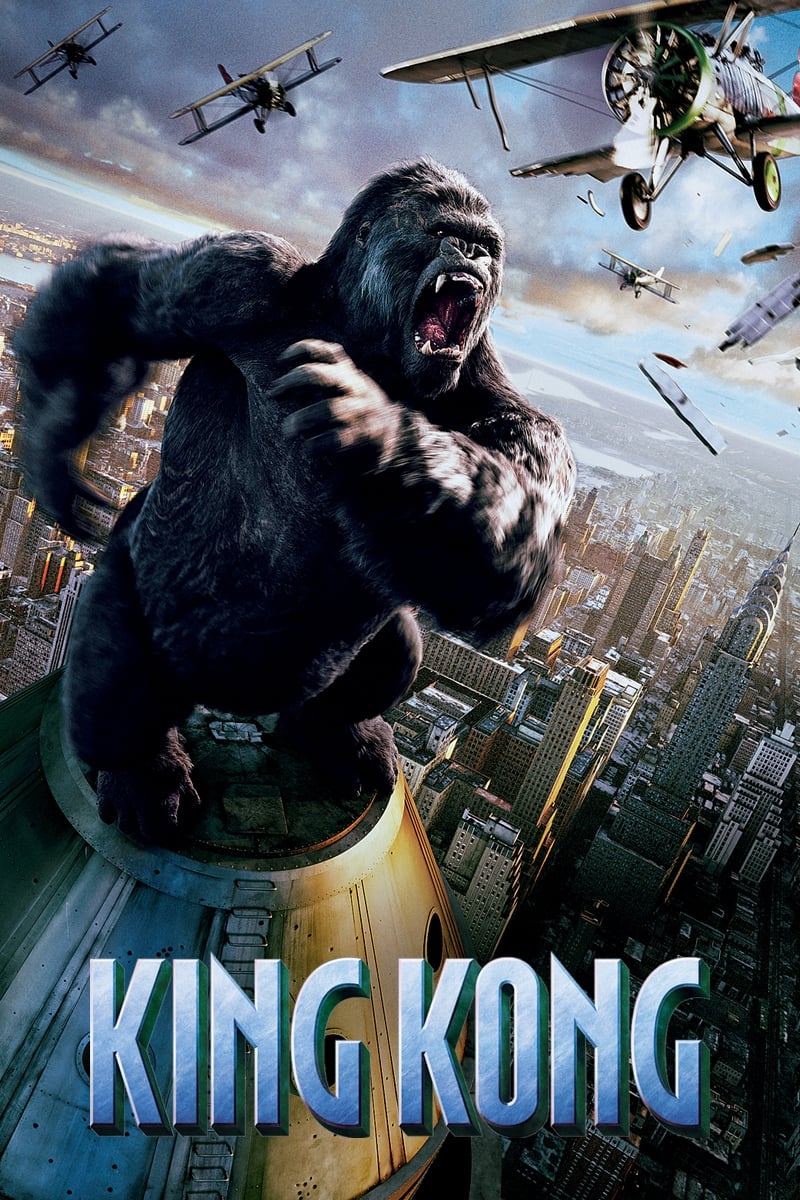
In 1933 New York, an overly ambitious movie producer coerces his cast and hired ship crew to travel to mysterious Skull Island, where they encounter Kong, a giant ape who is immediately smitten with the leading lady.
28 Nov King Kong (2005)
The Tempest
We can all celebrate. Jackson has now solidly replaced Spielberg.
Most folks know that the 1933 “Kong” changed the world in fundamental ways. The world of movie imagination was in its earliest phases, so quite apart from the innovations of animation and dramatic scoring, the engineering of the narrative was radical and important — the idea of making a movie about making a movie. Was it the first major film with such explicit folding?
It is a movie about the making of a movie that gets out of hand so the inner movie takes over the enclosing one. Then a larger crew gets involved and subdues the “beast“ (the energy of the thing) and recasts it as a slightly different type of show, the “real” thing. This also gets out of hand in the same way. The form is nominally a beauty and the beast love story, but inside it is a similar beauty and the beast story about the notions of dangerous storytelling.
Fortunately, we have the Jackson of “Forgotten Silver,” “Heavenly Creatures” and “Meet the Freebles,” all in this family of reflection.
This Kong sets the human lover as the actual playwright who (literally) is writing what we see as we go along. He intends to be outside the play, but gets swept up in it as the venture (again, literally) leaves with him aboard. When looking for an actress, Denham asks about Fay, and is told she is filming something for RKO, the original Kong, in fact.
The big layer is that when the Kong show comes to 1933 New York, the costumes and music are from the 1933 film. How clever, to overlap the layer of original-remake with that in the story of movie within layered on the “real” thing. The business about the monster coming off the stage/screen and entering the audience is a fold-shifting device visited many times since.
I understand there are a quite a few more subtle ‘movie within the movie” touches that Jackson intends to add in the DVD cut. We see one in the trailer where the inner filmmaker is directing Ann to scream.
Jackson cleverly adds in a few narrative references as well. This is an intelligent filmmaker, after all. The obvious one is “Heart of Darkness,” (and by reference, “Apocalypse Now”), which he slips in explicitly and then satirizes by that quaint foolishness of the mentor and lost boy.
But the insertion he makes that is not explicit is the one that fascinates me: “The Tempest,” sort of a touchstone for this notion of folded narrative and how it is added as yet another layer is a pleasant surprise.
If (shame) you don’t know the Tempest, here is an outline: a magician (Shakespeare who is both in the play and writing it) lives on a lost island with magical creatures. He conspires to raise the titular tempest which brings a shipload of folks to the island where he works his magic. His conjuring of the tempest presumably goes back in time to include all the events leading to the reasons the people are on the ship.
The tempest involves an enveloping fog, rocks that appear from nowhere and no escape for experienced mariners.
Once on the island, there are a few plays-within-plays created and manipulated by the magician, some exposure to the feral animal energies of the place, and a love between a young couple. There’s much ado about the abject loneliness of our magician.
(Incidentally, implicit in this Kong story is that this monster ape is the very last in the line. When he takes his new love to see the sunset, he takes her past the family boneyard. There, you can see that there was a long line of giants before him that at each stage had a loved companion where he does not.)
Quite apart from that, you can see Ted’s law at work here and in “The Tempest.“ That law holds that when you have two layers, a film and a play or film within, the distance of abstraction between us and the outer film is the same as that between the outer film and the inner one. This is true in the four explicit inner plays: the movie Denham makes, the play Jack writes (where he talks to himself about love), the Kong show (which references the 33 movie) and the stage performances Ann does throughout, including for Kong (which is pure Jackson).
All this business about narrative dimension is mirrored in the physical dimensions as well. Jackson knows how to work in the three dimensions that animation gives him the freedom to exploit. At least we got that out of his adventures with fascist romantic cosmology. If you just watched the fight between Kong and the two dinos suspended by vines as they and we swoop about, you’d get your money’s worth. And that would be both in entertainment and knowing you are seeing something that will change all action movies that follow. The planes at the end have camera perspectives we haven’t seen before as well.
This is a masterwork. My one complaint is the lack of sex. Yes, I know. Mooneyes are enough, and anything more works against the abstraction of the thing. But that business about smell in the 33 version was piercingly raw and human. It is a shame that to sell big it had to be replaced with some business about her “entertaining” him. But it does keep the performance levels straight.
Posted in 2006
Ted’s Evaluation — 3 of 3: Worth watching.


No Comments